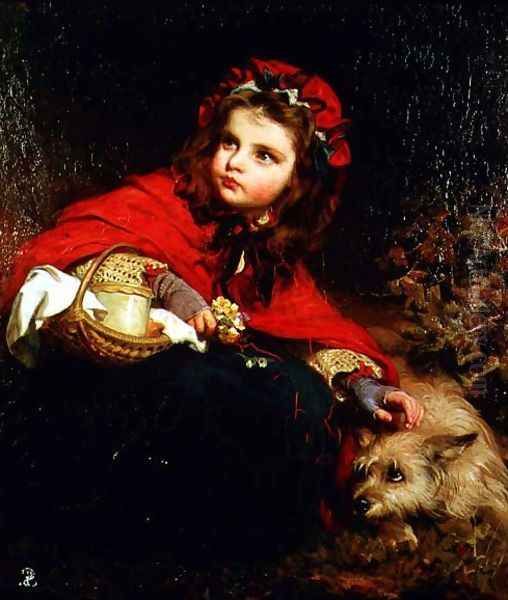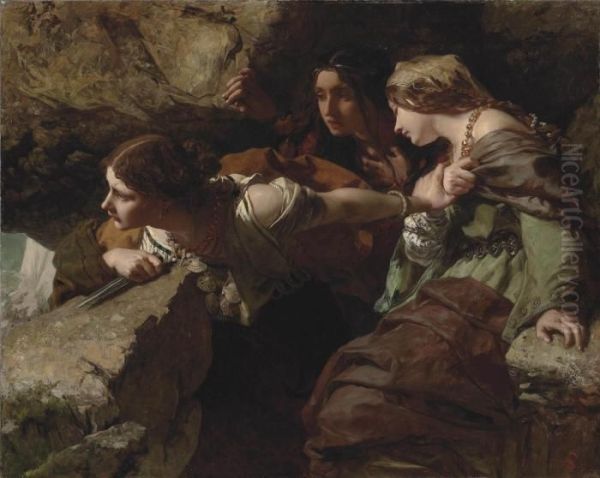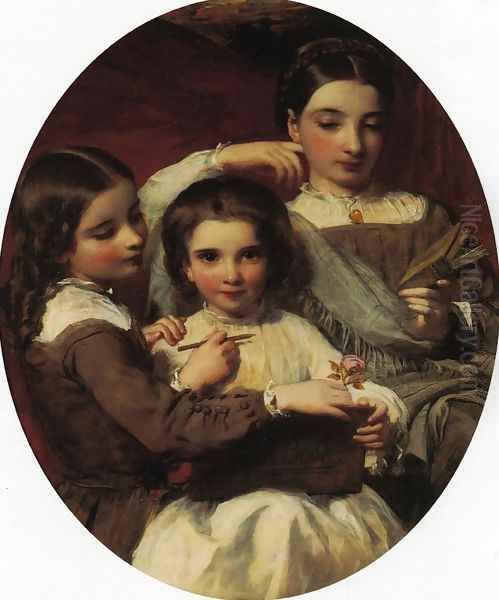
James Sant (1820-1916) stands as a prominent figure in the landscape of 19th-century British art. Renowned primarily for his captivating portraits, especially those of women and children, Sant carved a distinguished career that spanned nearly the entirety of Queen Victoria's reign and beyond. His ability to capture not just a likeness but also the spirit and innocence of his subjects, particularly the young, earned him widespread acclaim and the affectionate title "the King of Children." Appointed as Principal Painter in Ordinary to Queen Victoria, his work provides a fascinating window into the social fabric, aesthetic sensibilities, and familial affections of Victorian England.
Early Life and Artistic Formation
Born on April 23, 1820, in Croydon, Surrey, James Sant was immersed in an artistic environment from a young age. His family nurtured creative pursuits; notably, his brother George Sant and sister Sarah Sant also became artists, suggesting a household where artistic talent was encouraged and cultivated. This familial background likely provided James with early exposure to the principles of art and the life of a painter, laying a foundational interest that would define his long and prolific career.
Sant's formal artistic education began under the tutelage of the esteemed watercolourist John Varley. Varley, known for his romantic landscapes and as a teacher to several significant artists including William Turner (in his early days), David Cox, and John Linnell, would have imparted a strong grounding in draughtsmanship and the handling of light and atmosphere. Following his studies with Varley, Sant sought further instruction from Sir Augustus Wall Callcott, a distinguished landscape and marine painter who was also a Royal Academician. Callcott's influence likely broadened Sant's understanding of oil painting techniques and composition, particularly in genres beyond portraiture, even if portraiture would become his mainstay.

To consolidate his training, Sant enrolled in the prestigious Royal Academy Schools. Admission to the Schools was a significant step for any aspiring artist, offering access to life drawing classes, lectures by leading academicians, and the opportunity to study classical casts. It was here that Sant would have honed the technical skills essential for a successful career, particularly in an era when academic proficiency was highly valued. He began exhibiting at the Royal Academy from the age of twenty, a testament to his developing talent. An early notable work exhibited in 1840 was a portrait of his father, William Sant, signaling his emerging focus on portraiture.
The Ascent of a Portrait Master
Throughout the 1840s and 1850s, James Sant steadily built his reputation. His dedication to portraiture, combined with a sensitive and appealing style, began to attract significant attention. A pivotal moment in his early career came in 1853 with the exhibition of his painting The Infant Samuel. This work, depicting the young biblical prophet in a moment of pious contemplation, struck a chord with the Victorian public's appreciation for religious sentiment and childhood innocence. The painting's popularity was immense, further amplified by the widespread sale of engravings, making Sant's imagery accessible to a broader audience beyond the confines of art galleries.
This success was not isolated. Around the same period, other works like Little Red Riding Hood (1853) and images that would become popular as prints, such as The Soul's Awakening, further cemented his fame. These paintings demonstrated Sant's particular gift for capturing the charm, vulnerability, and burgeoning character of children. He possessed an uncanny ability to connect with his young sitters, eliciting natural expressions and poses that avoided the stiffness often found in formal portraiture of the era. This empathetic approach distinguished him from many contemporaries and was a key factor in his enduring appeal.
His portraits of children were not merely sentimental; they often conveyed a depth of character and an observational acuity that elevated them beyond simple likenesses. He understood the fleeting nature of childhood and sought to capture its essence with a gentle, almost reverent touch. This skill led to him being dubbed "the King of Children," a moniker that acknowledged his preeminence in this particular, and highly popular, subgenre of portraiture. His contemporaries in portraiture, such as Sir Francis Grant, who was President of the Royal Academy from 1866 to 1878, or later figures like John Singer Sargent (though Sargent's bravura style was quite different), also painted children, but Sant's name became particularly synonymous with the tender depiction of youth.
Portraying Victorian Society and Elegance

While renowned for his depictions of children, James Sant was also a highly sought-after portraitist of adults, particularly women of the Victorian aristocracy and gentry. His portraits of ladies were admired for their elegance, refinement, and the graceful manner in which he rendered fabrics, complexions, and expressions. He navigated the expectations of society portraiture with skill, creating images that were both flattering and insightful. His female sitters were often depicted in fashionable attire, their poses conveying a sense of poise and social standing, yet Sant often managed to imbue these portraits with a subtle psychological depth.
His style, characterized by smooth brushwork, a delicate palette, and a masterful handling of light and shadow, was well-suited to the prevailing tastes of the Victorian era. He was adept at creating a sense of volume and presence, making his figures appear lifelike and engaging. This contrasted with the more overtly detailed and often symbolic approach of the Pre-Raphaelite Brotherhood, whose key figures like Dante Gabriel Rossetti, John Everett Millais (in his early phase), and William Holman Hunt were his contemporaries and offered a very different aesthetic vision. Sant's work remained more aligned with the established academic traditions, albeit infused with a distinctive personal charm.
He exhibited regularly at the Royal Academy, a crucial venue for any artist seeking patronage and critical recognition. His consistent presence there, with works that appealed to both critics and the public, led to his election as an Associate of the Royal Academy (ARA) in 1861, and subsequently as a full Royal Academician (RA) in 1869 or 1870. These accolades signified his esteemed position within the British art establishment, placing him among the leading painters of his day, alongside figures like Lord Frederic Leighton, who would later become President of the Royal Academy, and Sir Edward Poynter.
Principal Painter to Queen Victoria
The pinnacle of James Sant's official recognition came in 1871 (some sources state 1872) when he was appointed Principal Painter in Ordinary to Queen Victoria. This prestigious role, previously held by artists such as Sir David Wilkie and Sir George Hayter, involved creating portraits of the Queen and members of the Royal Family. It was a mark of supreme royal favour and cemented Sant's status as one of the foremost portraitists in the kingdom.

In this capacity, Sant produced numerous portraits of Queen Victoria's children and grandchildren. Among these were likenesses of Prince Leopold, Duke of Albany, and Princess Beatrice. He also painted a poignant portrait of Prince Alemayehu of Abyssinia, the orphaned son of Emperor Tewodros II, who was brought to England and became a ward of Queen Victoria. Sant's ability to capture the innocence and individuality of these royal children, while adhering to the decorum required of court portraiture, was highly valued. These royal commissions not only brought him further fame but also ensured his work was seen by a wide and influential audience.
His royal portraits, like his other works, were characterized by their sensitivity and charm. He managed to convey the youthfulness of his royal sitters without sacrificing the dignity of their station. The Queen herself was known to have a particular fondness for children, and Sant's sympathetic portrayals would have resonated with her maternal sensibilities. This royal patronage undoubtedly contributed to the high demand for his work among the aristocracy and the wealthy middle classes, who sought to have their own families immortalized by the Queen's favoured painter.
Artistic Style, Influences, and Diverse Subjects
James Sant's artistic style, while evolving over his long career, retained certain core characteristics. He was a master of chiaroscuro, using light and shadow effectively to model form and create a sense of depth and atmosphere. His colour palettes were often subtle and harmonious, with a particular skill in rendering flesh tones and the textures of fabrics. While his work is generally considered within the academic tradition, it often possessed a softness and intimacy that set it apart.
The provided information suggests influences from Italian Renaissance masters, though it's perhaps more accurate to say he drew from the broader tradition of Old Master portraiture, which would include Baroque painters like Sir Anthony van Dyck and Frans Hals, whose technical brilliance and psychological insight were benchmarks for portraitists. The elegance and aristocratic grace found in Van Dyck's English portraits, for instance, certainly find echoes in Sant's work. He would also have been aware of the great British portrait tradition established by Sir Joshua Reynolds and Thomas Gainsborough in the 18th century.
While portraiture was his primary focus, Sant did not confine himself to this genre. He also produced a number of subject pictures, often with narrative or allegorical themes. A notable example is Courage, Anxiety and Despair, Watching the Battle (c. 1850 or 1853), a work that attempts to convey complex human emotions through a dramatic scene. Other thematic works included Love's Messenger (1853). These paintings allowed him to explore different compositional challenges and emotional registers than those typically found in commissioned portraiture.

Furthermore, Sant painted landscapes, seascapes, and even animal subjects. His landscapes, particularly some later examples, are noted in some sources as showing a stylistic affinity with French Impressionism, perhaps in their looser brushwork or attention to atmospheric effects. While he was not an Impressionist in the vein of Claude Monet or Camille Pissarro, it's plausible that, like many artists of his generation, he was aware of and selectively absorbed aspects of newer artistic movements. His versatility across these genres, though less famous than his portraiture, speaks to a broad artistic curiosity and technical facility. He exhibited nearly 300 oil paintings throughout his career, many at the Royal Academy and also at the Grosvenor Gallery, an alternative exhibition space that became important in the later Victorian period, championed by artists like Edward Burne-Jones.
Notable Works and Their Reception
Several of James Sant's paintings achieved iconic status during his lifetime and remain significant examples of Victorian art.
The Infant Samuel (1853): As mentioned, this was a breakthrough work. Its combination of religious piety and childhood innocence resonated deeply with Victorian sensibilities. The widespread distribution of engravings made it a familiar image in many homes.
Little Red Riding Hood (1853): Another popular depiction of childhood, this time drawing on a well-known fairy tale. Sant's interpretation likely focused on the innocence and vulnerability of the protagonist, appealing to the era's fascination with childhood narratives.
The Soul's Awakening: This title, often associated with Sant, suggests a work of sentimental or spiritual reflection, likely featuring a young person, and was also popularized through prints. It captured the Victorian interest in moral and emotional development.
Courage, Anxiety and Despair, Watching the Battle (c. 1850/1853): This ambitious subject picture showcased Sant's ability to handle complex multi-figure compositions and convey strong emotions, moving beyond the realm of straightforward portraiture.
The Thorn Among the Roses (1887): The title suggests a symbolic or allegorical work, perhaps dealing with themes of beauty and hidden danger, or innocence contrasted with hardship, common tropes in Victorian art.
Royal Portraits: His numerous portraits of Queen Victoria's children, including Prince Leopold and Princess Beatrice, were significant commissions that enhanced his public profile. The portrait of Prince Alemayehu is also a notable and historically interesting piece.
The popularity of Sant's work was not limited to original canvases. The Victorian era saw a boom in the production and consumption of reproductive engravings. Artists like Sant, whose subjects had broad appeal, benefited greatly from this market. Engravings of his paintings, particularly those featuring children or sentimental themes, sold in large numbers, making his art accessible to a middle-class audience that might not have been able to afford an original oil painting. This widespread dissemination of his imagery contributed significantly to his fame and cultural impact. His works were collected by major institutions, including the Tate Gallery and the National Portrait Gallery in London, underscoring their artistic and historical importance.
Contemporaries and the Victorian Art Scene
James Sant worked during a vibrant and diverse period in British art history. The Victorian art world was dominated by the Royal Academy, which set artistic standards and provided the primary venue for exhibition and patronage. Sant was an established figure within this institution, alongside other prominent Academicians such as the aforementioned Lord Frederic Leighton, Sir John Everett Millais (who, after his Pre-Raphaelite phase, became an immensely successful society portraitist and President of the Royal Academy), George Frederic Watts (known for his allegorical "Hall of Fame" portraits), and Sir Lawrence Alma-Tadema (famed for his scenes of classical antiquity).
While Sant's style was generally more traditional, he was contemporary with various artistic movements and trends. The Pre-Raphaelite Brotherhood, with its emphasis on truth to nature, bright colours, and literary or religious subjects, offered a radical alternative to academic conventions in the mid-century. Later in the century, the Aesthetic Movement, championed by artists like James McNeill Whistler (though often in conflict with the establishment) and Albert Moore, prioritized beauty and artistic harmony ("art for art's sake") over narrative or moral content.
Sant's focus on appealing portraiture and sentimental genre scenes aligned well with mainstream Victorian tastes, which often favoured art that was emotionally engaging, morally uplifting, or aesthetically pleasing in a conventional sense. Portraitists like Frank Holl and Hubert von Herkomer, who often depicted subjects with a greater degree of social realism or psychological intensity, offered a different flavour of Victorian portraiture. Sant's particular niche was the graceful and charming depiction of the upper classes, especially their children. He was also an acquaintance of Charles Dodgson (Lewis Carroll), the author of Alice's Adventures in Wonderland, indicating his connections within the broader cultural sphere of Victorian England.
Later Career, Legacy, and Conclusion
James Sant enjoyed an exceptionally long career, continuing to paint and exhibit well into the early 20th century. His final work was exhibited at the Royal Academy in 1915, the year before his death. In a gesture of goodwill towards younger generations, he resigned his position as a Royal Academician in 1914, a move intended to create an opening for a younger artist. This act reflected a certain graciousness and an awareness of the changing artistic landscape.
He passed away on July 12, 1916, at the age of 96, having witnessed profound transformations in art and society. By the time of his death, artistic movements like Post-Impressionism, Fauvism, and Cubism had already revolutionized European art, making the Victorian academic style seem part of a bygone era. However, Sant's contributions remain significant.
James Sant's legacy lies primarily in his sensitive and skilled portraiture, which provides an invaluable visual record of Victorian society, particularly its elite and their children. His ability to capture the innocence and charm of youth earned him lasting affection and a distinct place in the history of British art. While tastes in art have evolved, his paintings continue to be appreciated for their technical accomplishment, their gentle sentiment, and the window they offer onto the aspirations and affections of the Victorian age. His works in national collections ensure that his contribution to the rich tapestry of 19th-century art is preserved and available for future generations to study and appreciate. He remains a testament to the enduring power of portraiture to connect us with the past and the individuals who inhabited it.